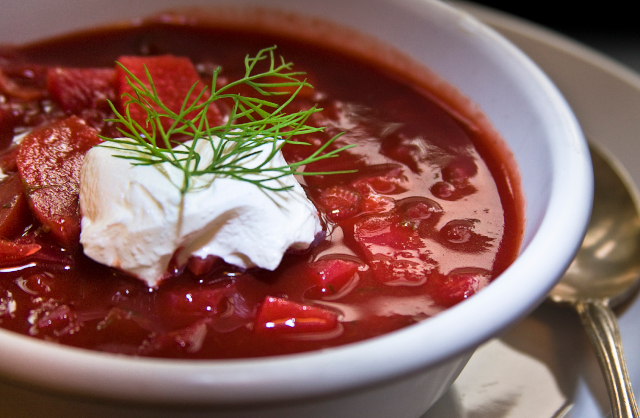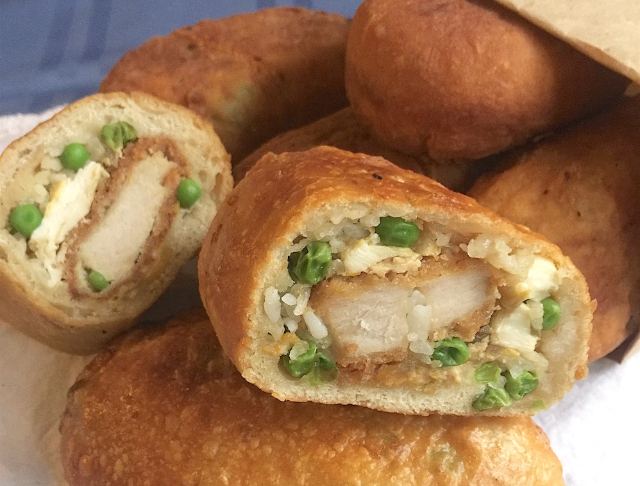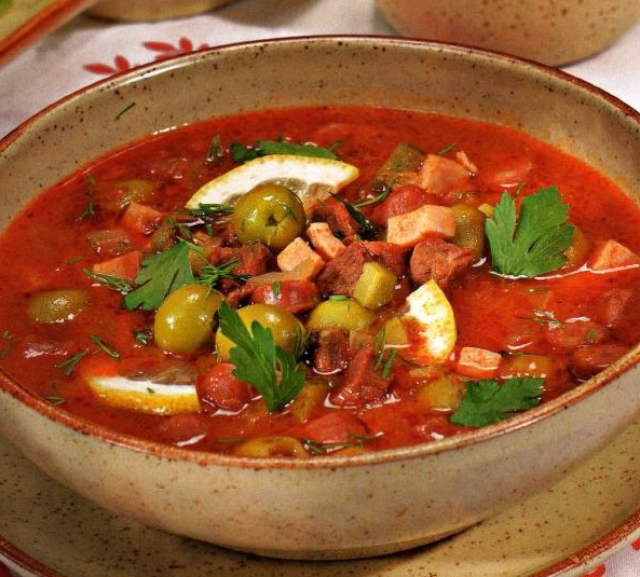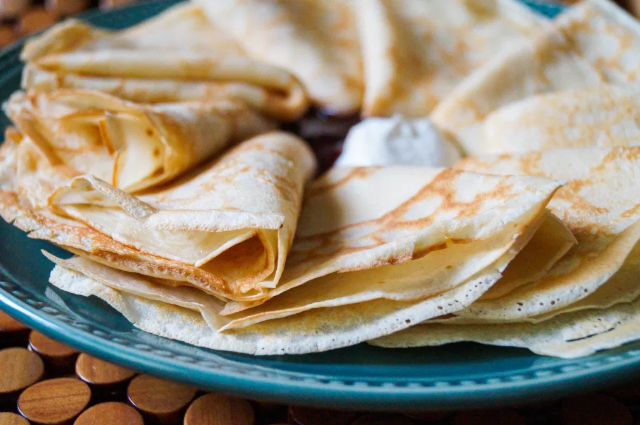A full two thirds of Russia (as far as I can discern from the map) is situated west of the Urals and north of what we in Canada consider the agriculturally productive zone. Perhaps that’s why so much of its population is settled in the west, and much of its cuisine has such close ties to that of its Western European neighbours…
 Borscht: Perhaps the most iconic of Russian dishes.
Borscht: Perhaps the most iconic of Russian dishes.
Ukraine was once called ‘Russia’s Breadbasket’, because it produced so much grain that it could feed not only itself by much of Western Russia, as well. And lets’ not forget the close ties other countries including Poland, Belarus and the Scandanavian nations have traditionally shared with Russia over the centuries. No wonder we find close cousins of many Russian dishes ingrained in the cuisines of those cultures, too.
So what do we expect to find on the menu in a country like Russia, much of whose geographical vastness is inhabited largely by hunters, herders and subsistence farmers? You might be surprised.
On our menu today:
Before we get into the ‘meat and potatoes’ stuff, let’s dispense with the most famous Russian comestibles: Borscht and Vodka…
Borscht: We have all heard of Russia’s famous cold Beet Soup. But did you know you can also eat it hot? Anyway, it’s more than just beets: usually including some kind of meat along with cabbage, carrots, onions, and potatoes. And that list just about summarizes Russia’s traditional, core veggie complement. Borscht is usually served with a dollop of sour cream on top. And isn’t quite the same without it!
Vodka: We think of Vodka first, if not close to first, when we think of Russian foods and beverages (see photo, top of page). As Wikipedia notes: “Traditionally, it is made by distilling the liquid from cereal grains that have been fermented, with potatoes arising as a substitute in more recent times, and some modern brands using fruits, honey, or maple sap as the base. […] Since the 1890s, standard vodkas have been 40 percent alcohol by volume (ABV) (80 U.S. proof). […] Vodka is traditionally drunk “neat” (not mixed with water, ice, or other mixers), and it is often served freezer chilled in the vodka belt of Belarus, Estonia, Finland, Iceland, Lithuania, Latvia, Norway, Poland, Russia, Sweden, and Ukraine. It is also used in cocktails and mixed drinks.”
Russians love their vodka so much that it’s consumed with everything at every occasion. It even comes in single-serve containers (much like Beer in the west) and is sold almost everywhere beverages are vended. You’ve probably heard the Guinness Beer slogan plumping its signature contention that ‘Guinness is good for you’: “It’s not just beer – its food!” That’s pretty much how Russians feel about Vodka.
Meat and Potatoes
Pelemni: Considered by many to be the national dish of Russia, these darling little dumplings are close cousins to Polish Pierogis. typi8cally, pastry shells are wrapped around round or oval balls of fillings and boiled. They can be served by themselves as a main, usually with sour cream, or as sides (normally the non-meat varieties).
Pirozhki: The best way to describe these little pockets of love is ‘Russian Turnovers’. They are simply pastry shells stuffed with potatoes, meat, cabbage, or cheese. Whatever you have, whatever you like.

They’re very closely related to Mexican and South American Empanadas, Indian Samoas and Cornish (British) Pasties: the pastry is folded over the filling and the open sides are crimped shut, and they’re baked until they’re golden brown and crispy.
Shashlyk: Grilled meats are popular all over Russia. Among the top favourites is Shashlyk, the Russian Kebab. Following the example of other Asian and European cuisines, Shashlyks are simply cubes of meat skewered with hunks of veggies (often potatoes, onions and sweet peppers).
Beef Stroganoff: A Russian dish so popular in the West it’s almost a stereotype. There are many recipes for this classic Russian dish depending on regional and personal preferences. But it’s always a stew of sautéed beef strips in a creamy sauce, often containing tomatoes and mushrooms. Correction: virtually always containing mushrooms! It is served over egg noodles, rice or potatoes.
Soups are big, really big…
As you might expect of a culture that is steeped in cooler climates, Russians love their soups and stews…
Shchi: This is a classic cabbage soup with many variations: It can be made with fermented cabbage or Saurkraut as well as fresh cabbage. Shchi is often served as a main with the addition of chicken or other meats. Veggie ingredients almost always include potatoes, carrots and onions – Russian root vegetable staples. Simmer everything together until the cabbage and potatoes are fork-tender.
Solyanka: There’s some debate as to whether this dish is a soup or a stew. Like other Russian favourites, Solyanka can be made with sausage, bacon, ham, or beef depending on what you have on hand and what you like.

Some folks also use fish. Veggies traditionally include diced cabbage, carrots, onions, and potatoes. In fact, meatless, veggie versions are not unknown. Chopped cucumber pickle is a key contributor to Solyanka’s signature flavour.
Ukha: This is a lesser-known Russian delicacy: Fish soup. It can be based on almost any fish you like and includes those old standbys, potatoes and carrots along with various fresh or dried herbs. It’s simmered long and slow until all ingredients are tender and the flavour is fully developed. Travellers who began visiting Russia in the 19th century are said to have proclaimed that Ukha one of the best Russian dishes.
Breads and sides
Rye Bread: Russian food is almost synonymous with Rye Bread: Dark or blonde, light or dense, there’s a signature Rye Bread style for every corner of Russia. Rye bread or bread dough is used as the fermentation base for Kvass – a fizzy beer-like beverage with a very low alcohol content, usually 1 percent ABV or less. It may be flavoured with fruits or sweet herbs. It’s extremely popular in Russia, and is commonly made at home.
Blini: More or less, Russia’s version of a crèpe. Like its French cousin, this pancake-like whole wheat bread is usually rolled with fillings ranging from jam to cheese to sour cream. Truth to tell, Blini can be enjoyed with any kind of filling you want to use.

More often than not, they’re just folded in four and dipped in sour cream as a snack or appetizer. Blini are simply an indispensable part of Russian life!
Smetana: The Russian word for sour cream. As you may have guessed, it’s present for almost every Russian meal, and shows up as an ingredient in many Russian dishes. Russian sour cream is always fresh and has a delightfully tangy flavour.
May I suggest…
One of my favourite Russian food references is The Russian Tea Room Cookbook, a collection of authentic Russian recipes featured by the late, great Russian Tea Room restaurant in New York City. The book was created with the intention of preserving the original Tea Room’s famous recipes after the spot closed in 2002. This little gem of a book is available in various editions on Amazon, priced from $6 to $255. Get the reprint paperback – its the content you’re interested in, not the fine binding!
And that’s just ‘the tip of the iceberg’ on Russian cuisine. Once you get into it, I predict you’ll spend a lot of time studying and making Russian dishes. They’re the perfect combination of simple, savoury and satisfying fare!
~ Maggie J.

